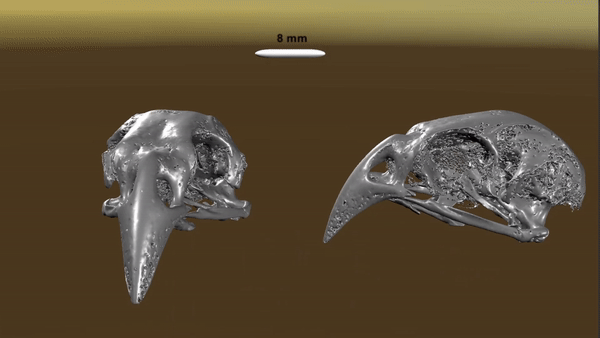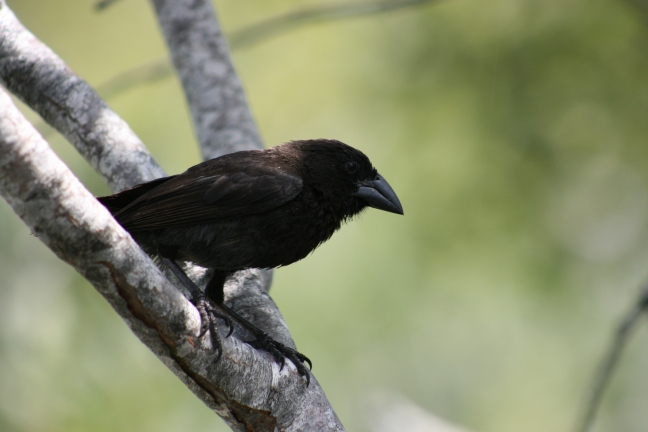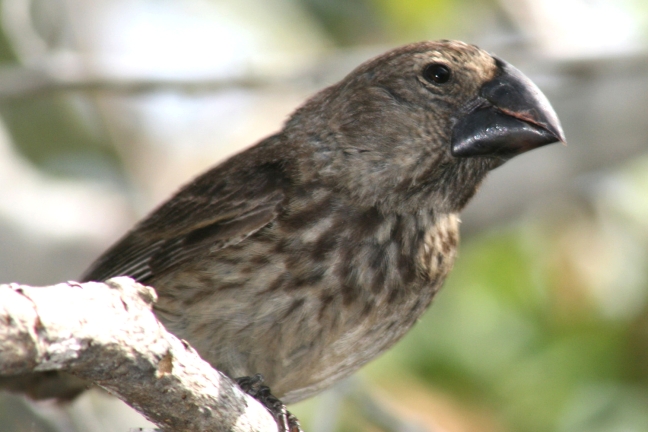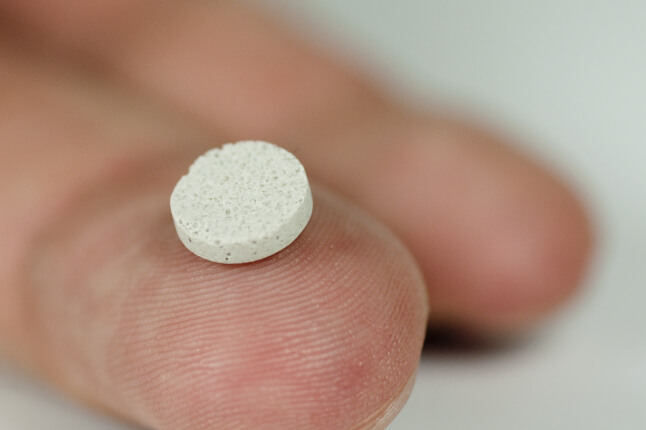News
Two million years before Charles Darwin and the crew of the HMS Beagle set foot on the Galápagos Islands, a small group of finches flew 600 miles from South America to make their home on this fiery, volcanic archipelago. They arrived as one species. By the time the Beagle landed, the finches had evolved into more than a dozen species, distinct from each other in size, vocalizations, and, most notably, beak shape.
What happened over the course of those two million years to separate these finches into distinct species was the basis of Darwin’s theory of evolution.
Today, Darwin’s finches are the classic example of adaptive radiation, the evolution of groups of plants or animals into different species adapted to specific ecological niches. On the Galápagos, finches evolved based on different food sources — long, pointed beaks served well for snatching insects while broad, blunt beaks work best for cracking seeds and nuts.
A large cactus finch
Large ground finch
This diversity of beak shapes is well studied from an evolutionary and biological perspective, but little is known about how these shapes came to be from a developmental, mathematical and physical perspectives.
Now, research from the Harvard John A. Paulson School of Engineering and Applied Sciences (SEAS) combines evolutionary biology and developmental genetics with geometry, biophysics and biomechanics to develop a unified understanding of the growth, form and function of finch beaks.
The research is published in the Proceedings of the National Academies of Sciences (PNAS).
“Evolution selects from random mutations but how do these random mutations result in specific shapes that can perform specific functions,” said L Mahadevan, the Lola England de Valpine Professor of Applied Mathematics, of Organismic and Evolutionary Biology, and of Physics, and senior author of the study. “Previous research has focused separately on the evolutionary parameters of beak shape, and their mechanical function but we have brought new perspectives to analyze beak shape at multiple levels by combining geometry and dynamics.”
“Using these different perspectives, we developed a simple mathematical model to quantify the nature of beak shape variations, study how these variations emerge from changes in development of the birds, and understand their functional significance as a mechanical tool,” said Salem al-Mosleh, a postdoctoral fellow at SEAS and first author of the study.
The interdisciplinary team of researchers included biologists, physicists and mathematicians from Harvard, MIT and Imperial College London. They began by analyzing a set of high-resolution, 3D CT scans of finch beaks, focusing on their geometries.

Three-dimensional scan of finch beaks
“We found a simple, mathematical relationship to describe and characterize the beak shape,” said Gary Choi, a former graduate student at SEAS and currently a postdoctoral fellow at MIT, and co-author of the study. “This mathematical functional form allowed us to compare beak shape across species and further characterize the all the varieties of beak shapes.”
The researchers quantified the mechanical performance of each beak shape by studying the relationship between geometry, diet and biomechanics. This approach allowed the researchers to connect form and function, shedding light on how beak shapes can crush bigger seeds or close faster around an insect.
“Once we connected form and function, the next question is how do these shapes actually grow and develop,” said al-Mosleh.
The team developed a cellular growth model that explains how beak shapes emerge as a result of various factors and can reproduce actual beak shapes. Interestingly, the model was also able to predict so-called impossible shapes, beak shapes that could technically crush seeds or grab insects more efficiently but could never actually evolve because of the physical constraints of development.
“If we were looking at beak shape from a purely evolutionary perspective, we would never be able to find these impossible shapes because we wouldn’t be taking into account all the other constraints that impact beak growth,” said Choi. “Our research is connecting everything that shapes finch beaks from the small-scale cellular processes to the large-scale evolutionary processes.”
Next, the researchers aim to apply this approach to other animals, including Hawaiian honeycreepers.
“How these developmental changes actually occurred will remain shrouded by the fog of time, but our hope is that our analysis linking form, function and evolution in the context of Darwin’s finches might serve as a jumping off point for other similar ventures that might help gradually illuminate these mysteries,” said Mahadevan.
The research was co-authored by Arkhat Abzhanov. It was supported in part by the National Science Foundation under Grant No. DMS-2002103 and No. NSF-1257122, the Harvard Quantitative Biology Initiative and the NSF-Simons Center for Mathematical and Statistical Analysis of Biology at Harvard, award no. 1764269.
Topics: Applied Mathematics, Bioengineering
Cutting-edge science delivered direct to your inbox.
Join the Harvard SEAS mailing list.
Scientist Profiles
L Mahadevan
Lola England de Valpine Professor of Applied Mathematics, of Organismic and Evolutionary Biology, and of Physics
Press Contact
Leah Burrows | 617-496-1351 | lburrows@seas.harvard.edu





